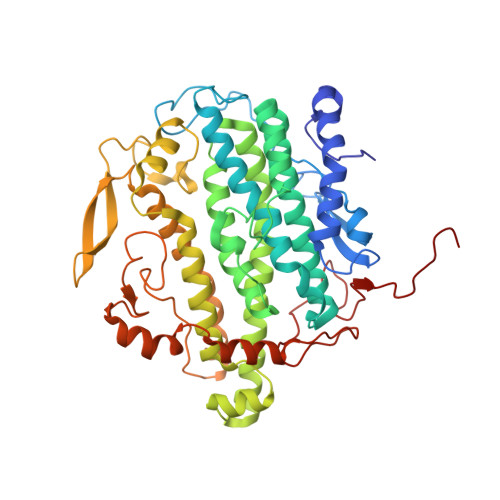Structure and Mechanism of the Diiron Benzoyl-Coenzyme A Epoxidase BoxB.
Rather, L.J., Weinert, T., Demmer, U., Bill, E., Ismail, W., Fuchs, G., Ermler, U.(2011) J Biological Chem 286: 29241-29248
- PubMed: 21632537
- DOI: https://doi.org/10.1074/jbc.M111.236893
- Primary Citation of Related Structures:
3PER, 3PF7, 3PM5, 3Q1G - PubMed Abstract:
The coenzyme A (CoA)-dependent aerobic benzoate metabolic pathway uses an unprecedented chemical strategy to overcome the high aromatic resonance energy by forming the non-aromatic 2,3-epoxybenzoyl-CoA. The crucial dearomatizing reaction is catalyzed by three enzymes, BoxABC, where BoxA is an NADPH-dependent reductase, BoxB is a benzoyl-CoA 2,3-epoxidase, and BoxC is an epoxide ring hydrolase. We characterized the key enzyme BoxB from Azoarcus evansii by structural and Mössbauer spectroscopic methods as a new member of class I diiron enzymes. Several family members were structurally studied with respect to the diiron center architecture, but no structure of an intact diiron enzyme with its natural substrate has been reported. X-ray structures between 1.9 and 2.5 Å resolution were determined for BoxB in the diferric state and with bound substrate benzoyl-CoA in the reduced state. The substrate-bound reduced state is distinguished from the diferric state by increased iron-ligand distances and the absence of directly bridging groups between them. The position of benzoyl-CoA inside a 20 Å long channel and the position of the phenyl ring relative to the diiron center are accurately defined. The C2 and C3 atoms of the phenyl ring are closer to one of the irons. Therefore, one oxygen of activated O(2) must be ligated predominantly to this proximate iron to be in a geometrically suitable position to attack the phenyl ring. Consistent with the observed iron/phenyl geometry, BoxB stereoselectively should form the 2S,3R-epoxide. We postulate a reaction cycle that allows a charge delocalization because of the phenyl ring and the electron-withdrawing CoA thioester.
- Mikrobiologie, Institut für Biologie II, Universität Freiburg, Schänzlestrasse 1, D-79104 Freiburg.
Organizational Affiliation:




















